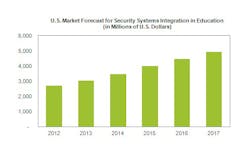Rapid growth projected for security system integration in U.S. schools
The U.S. market for school security system integration is expected to rise by more than 80 percent over the next five years, increasing from $2.7 billion in 2012 to $4.9 billion in 2017, according to new research from IHS.
In fact, according to a new report entitled “Vertical Insights: Video Surveillance & Security in Education,” double-digit growth is expected every year throughout the forecast.
The research firm says that high-profile shootings such as last year’s massacre at Sandy Hook Elementary School have had a huge impact on school officials and their views of how security systems should work.
“Instead of serving as forensic tools that provide evidence of events that have already occurred, security systems now are expected to help educational institutions detect and mitigate problems as they happen,” said Paul Bremner, video surveillance and security services market analyst at IHS. “Because of this, schools are employing security system-integration providers, which provide technologies and services that combine multiple safety mechanisms into a cohesive solution.”
IHS said video surveillance and security systems that can reduce the possibility, or that provide quicker response times to incidents as they are occurring, have an advantage over those that cannot.
“Video surveillance and security systems in the education sector must be flexible enough to deal with multiple types of threats,” Bremner added. “The types of threats an educational institution may encounter change during the course of a day. During the daytime, the main issue is access control, restricting who comes onto the premise and ensuring any potential threats remain outside. At night, the security system must deal with protection against vandalism.”
In the past, the research firm said that school security solutions have centered on a combination of physical access control and emergency notification systems. Although this may still be a strong focus for many schools, there now is much higher demand for video surveillance in educational institutions. IHS said that the growth rate of the video surveillance equipment market in the education sector is more than double that of the equipment market for physical access control.
“In addition to dealing with threats, video surveillance systems in the education sector have the added advantage that they can be used for a broad range of tasks, including gathering evidence for a criminal investigation; acting as a deterrent for theft, assault and vandalism; or simply by providing greater visibility to the school’s security staff,” Bremner concluded.
For more information about this report, visit www.ihs.com.
About the Author
Staff Reports
Editorial and news reports authored by the media team from Cygnus Security Media, including SecurityInfoWatch.com, Security Technology Executive magazine and Security Dealer & Integrator (SD&I) magazine.
